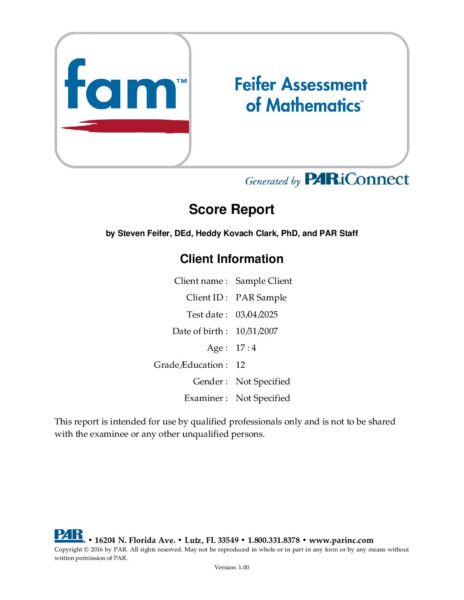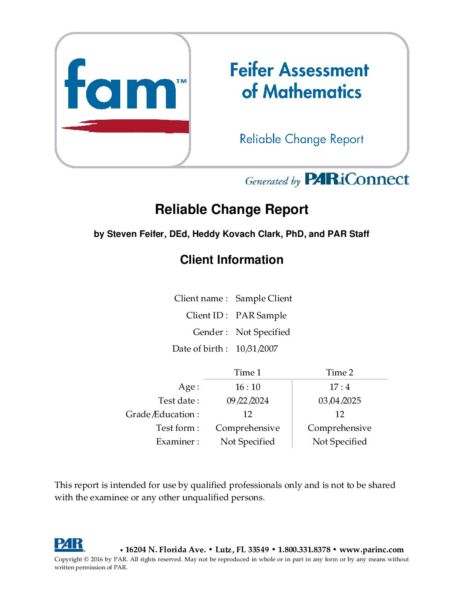
Feifer Assessment of Mathematics [FAM]
Examines the underlying neurodevelopmental processes that support proficient math skills
For Ages: Preschool to High school
Administration Time: 35 minutes for preschool age; 50 minutes for K – Year 2; 60 minutes for Year 3+
Format: Paper and pencil, Online scoring via PARiConnect
Authors: Steven G. Feifer, DEd; Professional Manual by Steven G. Feifer, DEd, and Heddy Kovach Clark, PhD
Printed Kits
Click to browse products
Printed Manuals
Physical printed manuals.
Printed Forms & Handscoring Materials
Test forms, response booklets and scoring reference manuals.
Online Forms, Reports, Kits & e-Manuals
All online resources including Forms, Reports, i-Admins, Kits and e-Manuals.
FAM Comprehensive Kit Australian Adaptation
FAM Professional Manual with Fast Guide
FAM Examinee Response Forms (10) Australian Adaptation
FAM Examiner Record Forms (10) Australian Adaptation
FAM online Interpretive Report (each) min order 5
FAM online Score Report (each) min order 5
The FAM helps you identify the specific subtype of Dyscalculia and recommends Math interventions.
The FAM is a comprehensive assessment of mathematics designed to examine the underlying neurodevelopmental processes that support the acquisition of proficient math skills. It is unique in that it helps you identify specific subtypes of dyscalculia to help inform intervention decision making.
Features and benefits
- Comprises 19 individual subtests measuring various aspects of math fact retrieval, numeric and spatial memory, perceptual estimation skills, linguistic math concepts, and core number sense development.
- Assists practitioners in not only determining the presence of a general math learning disability (MLD) but also in determining the specific subtype of dyscalculia in order to better inform intervention decision making.
- Can be used in conjunction with more traditional achievement tests (e.g., the AAB) that measure overall math performance.
- Based on a neuropsychological paradigm, which dictates that multiple neural pathways underscore various cognitive processes used in mathematical problem solving.
- Examinees in prekindergarten take nine subtests, examinees in kindergarten to Grade 2 take 14 subtests, and examinees in Grade 3 to college take 18 subtests.
- The FAM Interpretive Report on PARiConnect provides scores for all 19 subtests and includes detailed interpretations of index, index discrepancy, and subtest scores along with targeted math interventions based on current research tailored to the student’s age and FAM scores. View the FAM sample report.
- In-Person e-Stimulus Books and Kits are convenient alternatives to paper administration that allow you to administer the FAM face-to-face via tablet. Please download PAR’s white paper prior to administering.
- Read our white paper to learn more about using built-in skills, error, and behavior analyses with the FAR and the FAM to help you develop even more effective reading and math interventions.
- A separate Screening Form, ideal for progress monitoring, permits you to screen for dyscalculia and MLD and to identify the needs of at-risk students.
- If you are working within an RTI model or other treatment scenarios in which you wish to track progress over time, the Reliable Change Report can prove useful. After you administer the FAM more than one time to the same examinee (we recommend at least 30 days apart), you can track changes in performance for each subtest and index score. To generate a Reliable Change Report digitally, first enter your item responses into PARiConnect and then run an Interpretive or a Score Report. The second step is to generate the no-cost “Reliable Change” report. If you are hand scoring, page 4 of the Examiner Record Form provides space to calculate reliable change by hand.
 NZ
NZ







